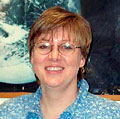 |
|
|
| Author |
Message |
Kayla Schomer
Guest

|
 Posted:
Sat May 29, 2004 8:50 am Posted:
Sat May 29, 2004 8:50 am |
  |
My name is Kayla Schomer and I was assigned to ask you a couple of questions for my earth science class. It would be great if you took the time to indulge them and reply.
1. What is the rate of global warming?
2. What type of animal contact and events have you experienced?
3. What type of marine samples are you collecting? |
|
|
|
 |
Patty_Cie

Joined: 23 Mar 2004
Posts: 87

|
 Posted:
Sat May 29, 2004 8:52 am Posted:
Sat May 29, 2004 8:52 am |
  |
Hello Kayla,
What grade are you in and where do you go to school (name of school,
city and state)?
| Quote: |
| 1. What is the rate of global warming? |
I know I am not qualified to answer this question, so I asked Dr. Lee
Cooper from the University of Tennessee to share his knowledge and
expertise. After talking to Dr. Cooper I think the idea of “global”
warming is difficult to pinpoint. The entire world is not experiencing
the same changes at the same time. For example, while certain parts of
the world are getting warmer (such as the 3-4 degree C temperature rise
in North America over the last 30-40 years), other places like Labrador
and Western Greenland have gotten cooler. Even in Greenland conditions
are not the same. At higher elevations records show an increase in snow
pack, but at sea level there is evidence of glaciers melting.
However, Dr. Cooper also told me that sea levels are rising world wide
at approximately 2 mm a year. One of the millimeters is from the
physical expansion of the seawater as it warms. The second millimeter
is from an increase in water volume as the northern polar glaciers
retreat in areas such as Alaska and parts of Greenland. What Dr. Cooper
and the other scientists working on the Shelf Basin Interaction project
are interested in is the environmental impact of the changes.
| Quote: |
| 2. What type of animal contact and events have you experienced? |
I have observed walrus and polar bear. I hope to see a bearded seal as
we travel further north. Additionally, through sampling I have seen and
touched crabs, copepods, brittle and cushion stars, polychaete and
priapulid worms, clams, snails and jellies.
Being on the Healy is quite an event. Ice breaking is very different
than I imagined. I thought icebreakers could plowed through the ice like
farmers plow through a field, easily piling the ice on either side of
ship-wide furrows. In reality, ice breaking is more like ice moving
with the ship pushing aside ice floes. When we meet a floe that is too
large to push aside, the ship runs up onto floe cracking it into smaller
floes. Then the ship pushes the smaller floes aside. It is fascinating
to watch. I have also been given the privilege of joining an ice recon
flight in a helicopter.
| Quote: |
| 3. What type of marine samples are you collecting? |
We are collecting water, optic measurements, zooplankton, benthic
organisms, sediments, and ice algae. From the samples the scientists
measure oxygen, thorium, radium, chlorophyll, stable isotopes, bacteria
productivity, bacteria respiration, zooplankton biomass, particulate and
soluble materials, zooplankton grazing rates and bio-optics. |
|
|
    |
 |
|
|
|
View next topic
View previous topic
You cannot post new topics in this forum
You cannot reply to topics in this forum
You cannot edit your posts in this forum
You cannot delete your posts in this forum
You cannot vote in polls in this forum
You cannot attach files in this forum
You can download files in this forum
|
Powered by phpBB 2.0.11
© 2001, 2002 phpBB Group :: FI Theme ::
All times are GMT
| |
